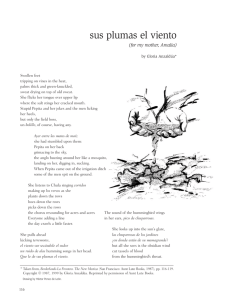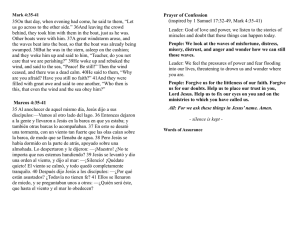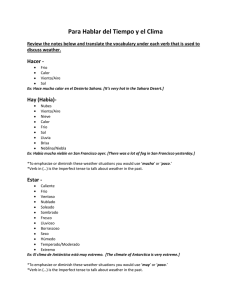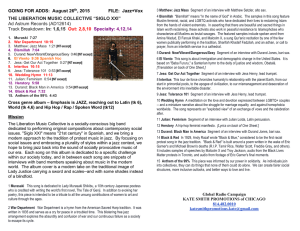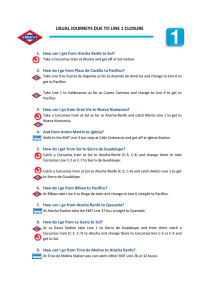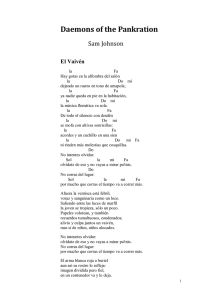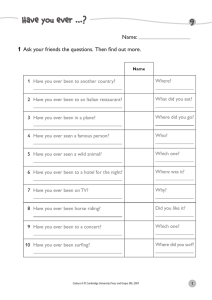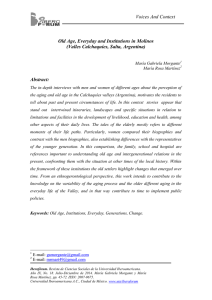Preface - McGraw Hill Higher Education
Anuncio
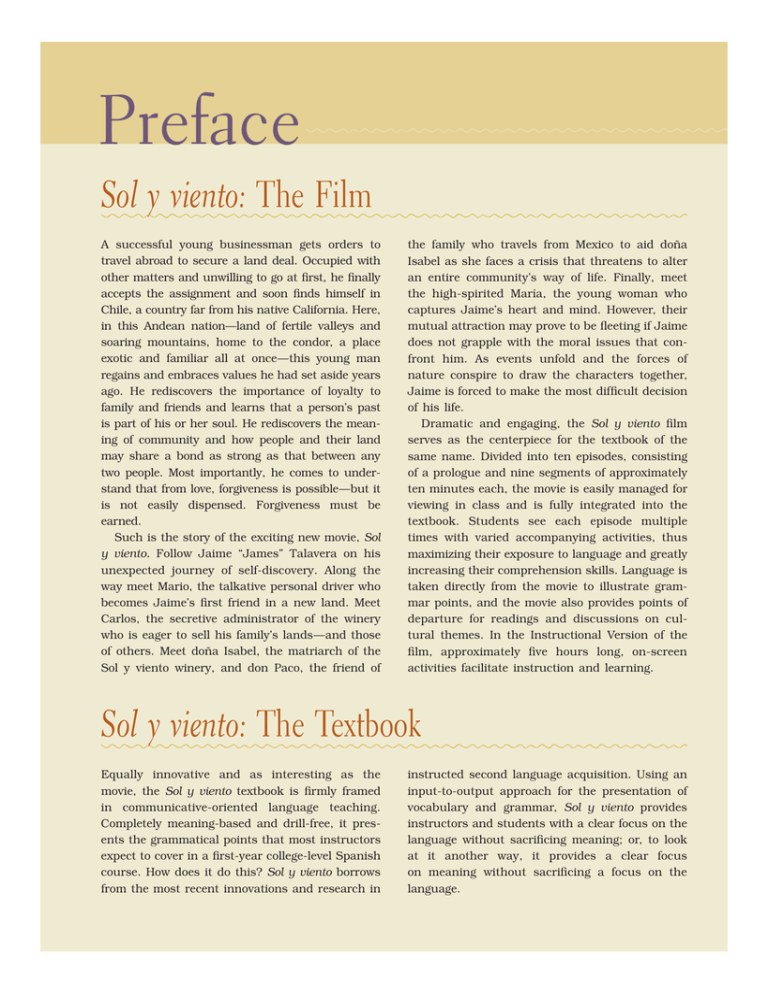
Preface Sol y viento: The Film A successful young businessman gets orders to travel abroad to secure a land deal. Occupied with other matters and unwilling to go at first, he finally accepts the assignment and soon finds himself in Chile, a country far from his native California. Here, in this Andean nation—land of fertile valleys and soaring mountains, home to the condor, a place exotic and familiar all at once—this young man regains and embraces values he had set aside years ago. He rediscovers the importance of loyalty to family and friends and learns that a person’s past is part of his or her soul. He rediscovers the meaning of community and how people and their land may share a bond as strong as that between any two people. Most importantly, he comes to understand that from love, forgiveness is possible—but it is not easily dispensed. Forgiveness must be earned. Such is the story of the exciting new movie, Sol y viento. Follow Jaime “James” Talavera on his unexpected journey of self-discovery. Along the way meet Mario, the talkative personal driver who becomes Jaime’s first friend in a new land. Meet Carlos, the secretive administrator of the winery who is eager to sell his family’s lands—and those of others. Meet doña Isabel, the matriarch of the Sol y viento winery, and don Paco, the friend of the family who travels from Mexico to aid doña Isabel as she faces a crisis that threatens to alter an entire community’s way of life. Finally, meet the high-spirited María, the young woman who captures Jaime’s heart and mind. However, their mutual attraction may prove to be fleeting if Jaime does not grapple with the moral issues that confront him. As events unfold and the forces of nature conspire to draw the characters together, Jaime is forced to make the most difficult decision of his life. Dramatic and engaging, the Sol y viento film serves as the centerpiece for the textbook of the same name. Divided into ten episodes, consisting of a prologue and nine segments of approximately ten minutes each, the movie is easily managed for viewing in class and is fully integrated into the textbook. Students see each episode multiple times with varied accompanying activities, thus maximizing their exposure to language and greatly increasing their comprehension skills. Language is taken directly from the movie to illustrate grammar points, and the movie also provides points of departure for readings and discussions on cultural themes. In the Instructional Version of the film, approximately five hours long, on-screen activities facilitate instruction and learning. Sol y viento: The Textbook Equally innovative and as interesting as the movie, the Sol y viento textbook is firmly framed in communicative-oriented language teaching. Completely meaning-based and drill-free, it presents the grammatical points that most instructors expect to cover in a first-year college-level Spanish course. How does it do this? Sol y viento borrows from the most recent innovations and research in instructed second language acquisition. Using an input-to-output approach for the presentation of vocabulary and grammar, Sol y viento provides instructors and students with a clear focus on the language without sacrificing meaning; or, to look at it another way, it provides a clear focus on meaning without sacrificing a focus on the language. In short, Sol y viento provides the instructor with a refreshing approach to grammar instruction and practice that fits well within the tenets of communicative language teaching. The materials allow instructors to maintain a simultaneous focus on both meaning and formal properties of language as students are engaged in learning about their classmates, their instructor, and the world around them. Paired with an exciting movie, the Sol y viento textbook provides students with a complete and effective beginning Spanish course that will lead them to higher levels of proficiency in comprehension and production than they might achieve with other materials. However, Sol y viento is not a set of learning materials focused on vocabulary and grammar alone. As a complete learning package, it presents abundant information on cultural topics relevant to the Spanish-speaking world, as well as opportunities for students to develop their reading and writing abilities. For a more detailed description on using the film and textbook together, please refer to the Instructor’s Manual and Testing Program or to the Instructor Edition on the Online Learning Center Website at www.mhhe.com/solyviento. More About Sol y viento: The Film One of the central themes examined in Sol y viento is the interaction between the forces of nature in the everyday lives of people. In fact, the sun (sol) and wind (viento) each play crucial roles in the film, as if they were characters themselves. Thus, “Sol y viento” is not just the name of a family winery; it displays the embodiment of elements of nature that help move the plot along. Cast of Characters Jaime A successful businessman from San Francisco, California, who travels to Chile to finalize a deal with the Sol y viento winery. María A Chilean university professor and anthropologist, who has always let her head rule over her heart. Carlos Proprietor and administrator of the Sol y viento winery, who is working on the deal with Jaime’s company. Isabel Carlos’ ailing mother and, with her nowdeceased husband, original proprietor of Sol y viento. Paco An old family friend of Isabel’s, who is called away from his native Mexico to help his friend in a time of need. Mario A taxi driver in Jaime’s employ during his stay in Chile. Traimaqueo The longtime foreman of the Sol y viento winery. Yolanda Traimaqueo’s wife and Isabel’s primary caregiver. Diego María’s student assistant at both the university and at anthropological dig sites. Who are the Mapuches? Throughout the course of the film, Sol y viento touches upon the plight of the Mapuche people and their struggle to retain their ancestral lands and maintain harmony with the Earth. The Mapuches are an indigenous people whose roots are found in southern and south central Chile and date back to thousands of years before the Europeans’ arrival in the western hemisphere. In Quechua, the language of the Mapuche, mapu means land and che means people, essentially making them “people of the land.” This connection to the Earth is deeply rooted in the spirit and culture of the Mapuche people. Since the 1880’s, when the nations of Chile and Argentina began to appropriate ancestral Mapuche lands, the Mapuches have strived to retain these lands and, later, to make their struggles known to the world at large. In Sol y viento, this struggle is shown by the attempt of outsiders to purchase Mapuche lands in order to build a large dam to flood the region and produce cheap hydroelectric power. [ In her book Mi país inventado, the acclaimed Chilean writer Isabel Allende relates a real-life struggle that echoes this theme in the film: Nuestros indios no pertenecían a una cultura espléndida, como los aztecas, mayas o incas; eran hoscos, primitivos, irascibles y poco numerosos, pero tan corajudos, que estuvieron en pie de guerra durante trescientos años, primero contra los colonizadores españoles y luego contra la república. Fueron pacificados en 1880 y no se oyó hablar mucho de ellos por más de un siglo, pero ahora los mapuches —«gente de la tierra»— han vuelto a la lucha para defender las pocas tierras que les quedan, amenazadas por la construcción de una represa en el río Bío Bío.* One of the Mapuche characters in the film, the machi, is a spiritual leader of her tribe. At the beginning of the film, we see her telling a tale to a group of adults and children. As her tale unfolds, we witness how the lives of Jaime, María, and others are intricately woven into her story and how the forces of nature conspire to bring resolution to the conflicts with which they are faced. ] The figurine seen here is a representation of a protective spirit in the beliefs of the Mapuche people. This spirit also plays an important role in the film, as you will see. *Our Indians didn’t belong to a grand culture, like the Aztecs, Mayas, or Incas; they were gruff, primitive, irritable, and few in number, but so brave that they waged war for 300 years, first against the Spanish settlers and then against the republic. They were pacified in 1880, and for more than a century you didn’t hear a lot about them. But now the Mapuches —people of the earth— have renewed their fight in order to defend the few lands they have left, threatened by the construction of a dam on the Bío Bío River. (Isabel Allende, Mi país inventado [Buenos Aires: Sudamericana, 2003], p. 56.) Sol y viento A Guided Tour of the Textbook 2B LECCIÓN EPISODI O 2 LECCIÓN 2A LECCIÓN 2B ¡Vamos de compras! OBJETIVOS a Episode Opener The text is divided into nine units (Episodios) with two lessons each (A and B), for a total of 18 regular lessons. Thus, Lecciones 1A and 1B correspond to Episodio 1 of the film, Lecciones 2A and 2B correspond to Episodio 2, and so forth. El encuentro Jaime and María meet in the park. you think broug What do ht them toget her? How did they meet? IN THIS LESSON, YOU WILL LEARN: OBJETIVOS a ■ how to talk about what people are weari ng more about stemchanging verbs in the present tense to talk about what peopl e do ■ the numb ers 100–1,000 ■ to use colors to describe clothing ■ to descr ibe places and things using demonstrative adjectives and pronouns ■ to talk about shopping and making purch ases ■ more about the verbs ser and estar to talk about conditions and traits ■ In addition, you will watch Episodio 2 of the film Sol y viento again. ¿Compras tú la ropa (Do you buy clothing) en una tienda elegante como esta (this one) en Barcelona, Españ a? What is Jaim e The doing follow in this ing media resou photo? Wher rces are available e do you think for this lesson he is? of Sol y viento: Lesson Opener Episodio 2 of Sol y viento Lesson Organization Each lesson is organized into three parts (Primera parte, Segunda parte, Tercera parte),* each of which contains a Vocabulario and Gramática presentation and accompanying activities. An audio recording of the Vocabulario presentations can be found on the Online Learning Center. *Lección 9B contains just the Primera parte and Segunda parte. WWW Interactive CD-ROM Online Learning Center Website a ¡Vamos… Let’s go shopping! Lesson openers provide a list of goals that prepare students for what they will learn in the lesson. 108 ciento ocho Online Manual de actividades Jaime is readi ng something on a small piece of paper. What does this look like? Is it a note? Some thing else? a El… The encou nter * PRIMERA PA RT E 116 ciento diec Vocabulario What La ropa A R T E Talking About We GarU N D A P People SE WWW ing on DescribC ERA TER PA la chaqueta W WW ble el impermea rojo/a WWW azul morado/a probarse (ue) la cliente marrón verde amarillo/a anaranjado/a s De compra Talking About Buying Things s de compras! Talking About Expected and Unexpected Qualities el traje Vocabulario rosado/a la corbata * la camisa –1,00 mbers 100 Colors; Nu la camis sas rojas. cientas blu Hay dosR TE la gorra los calcetines es los pantalon Vocabulario icua 124 ciento veint rónre Mo el cintu * Clothin negro/a * Shopping el probador los vaq gris el dinero blanco las sandalias la gang los zapatos crédito la tarjeta de de cuadros * de lunares de rayas with the and number BU LA RIO e in gender MÁ S VO CA need to agre ctives, colors Like all adje f scar caja modify. la they el dependiente wallet la bufanda e azules kings; pantyhos la cartera los vaqueros stocras clothing neg le of las medias las zapatillas artic shoes ropa de da high-heeled la pren la nblus altoa roja tacó de jas tos reba zapa loslas 00e of . . . mad 1.0 al re 100hey’ s del It’s/T tos/as Los número 600 seiscien cotton Es/Son de… tos/as 700 setecien leather algodón (m.) 100 cien ntos/as to uno/a l cien 101 depend 800 ochocie o woo cuer r en efectivo la /as cientos/as ester 900 novecientos dos el cliente paga 200 lana as tos/poly cien mil tres 0* (m.) 300 1.00 silkas poliéster ientos/ troc cua 400 seda ientos/as i to wea 500 quinMÁ CArBU LA RIO must agree S VO ify a noun, they … I’m looking fo llevar ugh 900 mod . Estoy buscando bers 200 thro buy May I try on to When the num do ¿Pue prar com ? s to spend in probarme… I’m just look ar tas persona cien gast dos to bargain estoy bres Sólo hom tearos ient rega quin to sell mirando. vender t size do Wha ? inexpensive ¿Cuál es su talla wear? a) in En barato/a expensive a comma (com What size sh you would use caro/a used where ¿Qué número (punto) is often do you wea a decimal point shopping *In Spanish, calza? 9% 64 pras 42 de com brand name Does it fit m ? la marca (fixed) price ¿Me queda bien think it’s a ) I (fijo io a el prec size Creo que le qued big on you de. la talla large un poco gran grande medium /a mediano small a pequeño/ How may I help o ¿En qué pued you? l ? * Gramática Está bien. Mo * re on ser and Up to this poin estar t someone’s phy you have been using the sical charact eristics or his verb ser with adjectives to describe or her persona Elena es eleg lity. ante. Elena is eleg Marcos es inte ant (by natu ligente. re). Marcos is (has These exampl always been) es commun icate inherent intelligent. something. To put it ano or ther way, they fundamental qualities like? (¿Cómo of someone answer the es?) or question Wha The verb esta t is he/she/i t pected change r can also be used with many adjectiv in someone’s in time. Not es to describ e that English personality or physical e an unexappearance often uses verb changes. at a given point s other than to be to des cribe these Elena está muy elegante . Elena looks Marcos está very elegant. más delgado . Marcos look When someon s (seems) thin e use s ner. esta conveyed is r with delgado that a person /a or guapo/a looks particu lar time, not , the messag larly thin or e nor mally that the pers good-looking on is nor mal words, thes e statements at a particu ly overweight answer the or unattractiv (¿Cómo está question How ?) e. In other does she/he Some adjectiv look or seem es that ? can be express ent equivalents ed with eith er ser or esta estar, the mea in English, depending r have diffe on which verb ning of verd ris e is green as of these com mon adjectiv in unripe. The used. When used with es for you. chart summar izes some * MÁ S GR AM ÁT ICA Although bien is usually tran slated into Eng it is usually translated as lish as well whe to be OK/ fine. n used with the verb esta Está bien. r, Estoy bien, grac It’s OK. / That ’s fine. ias. I’m fine, than ks. ¿Necesitan algo más? No, gracias. Do you all need Estamos bien anything else . ? No, thank you. We’re fine. Sol y viento SOL Y VIENTO Actividad A ¿Qué recuerdas? Based on what you remember from your previous viewing of Episodio 2, determine whether Jaime or María said each of the following lines. You will be asked to verify your answers when you watch the episode again. Actividad B ¿Cómo es María? Paso 1 How would you describe María, based on what you’ve seen of her in this episode? Sobre la lecturaa a ¡A… Let’s read! Vamos al cine Actividad A Antes de leer (Before reading) Paso 1 In a moment you will begin to look at a listing of movies for a theater in Spain. Before you do, think about what kind of information such a listing normally has. What do you expect to find? Estrategia Before reading anything in another language, it is always a good idea to make sure you know what it is that you are reading about and to first think about the topic. Is it fiction? Nonfiction? Is it self-help? Or is it something like a movie listing? By activating what you already know about either the type of reading or the possible content of the reading, you will maximize your comprehension as you explore the text. Paso 2 There will be some words you won’t recognize as you look at the movie listing. Just as in watching episodes of Sol y viento, it is fine to skip over anything you can’t grasp at first, especially if it’s not important to the task at hand. JAIME: JAIME: CABRITO: JAIME: CABRITO: ¿ ¡Chis! ¡ Ah, espere. , . Ya, Actividad C El episodio Now watch the episode again. Don’t forget to verify your answers to Actividad A as you watch. Also remember to pay close attention to the scene in which Jaime talks with the young boy in the park and to write down the missing words for Actividad B. a * Following each odd-numbered “B” lesson is a two-page reading section called ¡A leer! Each reading is realiabased—culled from a magazine or other publication—and contains pre- and postreading activities as well as reading strategies to help students focus on key information. Actividad C Nota cultural Look at the movie times once again. Do you notice anything about the latest movie showings? What does this suggest to you about the night life in Barcelona? Actividad D Un poco sobre el lenguaje (A little bit about language) Reading is a good way to learn new vocabulary and also to notice things about language. For example, find the following words in the movie listing and indicate whether they are masculine or feminine. How do you know? (Don’t worry that you don’t know their meanings yet, although some you might guess because they look like English words.) FEMENINO ■ ■ ■ ■ ■ ■ ■ ■ 133 ¡A leer! setenta y siete 77 Sobre… About the reading MASCULINO Paso 2 In this lesson you talked about how clothing can reflect the personalities of the people who wear it. Do any of the clothes that Jaime, Mario, and María wear represent their personalities in any way? Write brief descriptions of each character’s personality, based on his or her clothing. Compare your answers with those of three other classmates. zero in on a particular day and find out at what times the movie is playing find out the name of the theater and where it is located Use the following model to report to another person what you found. N AV E G A N D O L A R E D Find a website in Spanish for a theater or cinema. At what times and days are they offering a show or a movie? How does the schedule compare with the one you just read? * Entremés cultural Entremés cultural Entremés cultural * ciento treinta y siete 137 Cataluña, tiene una larga tradición de rivalidad con Madrid, la capital del país. Andalucía tiene una gran influencia árabe en su arquitectura y costumbres tradicionales debido ac España y México la ocupación de los musulmanes entre 711 d.C.d y 1492 (mil cuatrocientos noventa y dos) d.C. Es más,e en España varias autonomías son oficialmente bilingües. En Cataluña son WWW For comprehension and follow-up activities to accompany this reading, go to the Sol y viento Online Learning Center Website at www.mhhe.com/solyviento. Antes de leer oficiales el español y el catalán. En el País Vasco, el español y el vasco (una lengua no Here is a list of some new words and phrases you will encounter in the reading. Familiarize yourself with them before starting to read. el español coexiste con el gallego, una lengua más parecida al portugués que al español. Vocabulario útil las autonomías se caracteriza por la gastronomía los musulmanes parecido/a el vecino las comidas las costumbres las raíces indígena florecieron los rasgos románica cuyof origen todavía es un misterio) son las dos lenguas oficiales. En Galicia, En Valencia, las Islas Baleares y Navarra también son oficiales otras lenguas además del español. individual political entities or regions in Spain is characterized by gastronomy, cuisine Muslims similar neighbor foods customs, traditions roots indigenous, native flourished traits México, nuestro vecino al sur También lleno de contrastes, México tiene mucho en común con los Estados Unidos, su vecino al norte. Está dividido en treinta y un estados y un distrito federal (México, D.F., o la Ciudad de México). El nombre oficial del país es los Estados Unidos Mexicanos. Sin embargo,g el adjetivo unidos no refleja la diversidad que existe en el país. Por ejemplo, las comidas y costumbres de los estados de Oaxaca, Veracruz y Jalisco son tan diferentes como las de Nueva York, Luisiana y Nuevo México. A diferencia de España, en México todavía se conservan importantes raíces indígenas, especialmente en el centro España y México: Naciones de contrastes y sureste del país, es decir, en las regiones donde florecieron las grandes culturas mesoamericanas. La población indígena constituye un 10% (por ciento) de la población España, el estado de las autonomías en total y contiene más de cincuenta grupos con rasgos culturales que los diferencian Situada en la península Ibérica, en el suroeste del continente europeo, España se carac- del resto de la población. ¡En México se hablan más de sesenta y dos lenguas diferentes! teriza por su diversidad. Desde 1978 (mil Aguascalientes 1 S IENTAL RE OR CA M AD TE RRA SAN LUIS POTOSÍ de estas lenguas, el español es su NAYARIT segunda lengua. Sin duda, la influencia golfo de México indígena se manifiesta en numerosos Guanajuato Guadalajara León 8 4 3 O Ciudad de Puerto Vallarta ISC JAL 5 México Veracruz 9 MICHOACÁN 2 7 6 Puebla R ER U RA Taxco Z MA DR GUERRERO ED EL S UR Oaxaca Acapulco OAXACA O CÉ A N O P A CÍ F I CO YUCATÁN PENÍNSULA Campeche DE YUCATÁN CAMPECHE aspectos de la cultura de todas las regiones mexicanas como, por ejemplo, en sus fiestas religiosas, la gastronomía y las costumbres populares. C SI Mérida bahía de Campeche RA COLIMA Cozumel Tampico VE 1 AGUASCALIENTES 2 CIUDAD DE MÉXICO (DISTRITO FEDERAL) 3 GUANAJUATO 4 HIDALGO 5 MÉXICO 6 MORELOS 7 PUEBLA 8 QUERÉTARO 9 TLAXCALA ZACA S IE business Mazatlán A b Durango LO fishing SI A a Monterrey DURANGO N del país. Barcelona, la capital de AL NT IDE CC industriales principales y de negociosb EO La Paz tzeltal. Para muchos de los hablantes Nuevo Laredo COAHUILA M É X I C O RO O DR A M nia A lifor Ca UR LS de DE lfo IA go RN IF O País Vasco y Madrid son los tres centros Chihuahua INT ANA E por la industria pesqueraa y la gastronomía basada en esta. Cataluña, el zapoteco, el mixteco, el otomí y el río CHIHUAHUA de an Gr SI RR Asturias son dos autonomías famosas un millón de hablantes), el maya, el SONORA L CA JA BA E T OR ria y su realidad económica. Galicia y LN DE NIA situación geográfica, su clima, su histo- Las más extendidas son el nahuátl (con U N I D O S Ciudad Juárez Nogales OR tiene características distintas por su E S TA D O S LIF OCÉANO ATLÁNTICO en diecisiete autonomías, y cada región Tijuana CA E S P A Ñ A novecientos setenta y ocho) está dividida B AJA golfo de Vizcaya La Coruña Santander FRANCIA San Oviedo Bilbao Santiago de ASTURIAS CANTABRIA PAÍS Sebastián Compostela VASCO Pamplona GALICIA Logroño NAVARRA CASTILLA–LEÓN Vigo León Burgos LA RIOJA CATALUÑA río Eb Lérida r Zamora Valladolid o Zaragoza o r e u D río Barcelona Salamanca ARAGÓN Segovia Tarragona RRA DE GUADARRAMA Guadalajara Ávila SIE El Escorial Madrid Menorca MADRID Castellón Palma de PORTUGAL Toledo Mallorca rí o T a j o Cáceres Valencia a CASTILLAMallorca EXTREMADURA Ibiza dian COMUNIDAD r í o G ua LA MANCHA Mérida ISLAS BALEARES VALENCIANA Ciudad Albacete Real Badajoz Almadén A A MOREN mar Mediterráneo Alicante Linares SIERR MURCIA Córdoba Murcia v ir ISLAS CANARIAS al q u i Jaén Sevilla Lorca Guad Huelva Cartagena Lanzarote ríoANDALUCÍA Santa Cruz Granada de Tenerife Fuertegolfo de NEVADA La RRA ventura Cádiz SIE Almería Palma Tenerife Gran Jerez de la Frontera Málaga Canaria Cádiz Hierro Gomera Las Palmas de Gran Canaria QU Following each even-numbered “B” lesson is a two-page cultural reading called Entremés cultural. These sections focus on countries and regions in the Spanishspeaking world. Activities for these readings can be found on the Online Learning Center. 136 ciento treinta y seis TABASCO LA Entremés cultural BELICE MA Deseo ver la película . Se presenta (It is showing) los (días) (día) (hora) . Deseo ir el a la / a las . ¿Deseas ir conmigo (with me)? C H I A PA S UA TE MODELO: EVO LE ÓN ■ MARÍA NU ■ Paso 2 find a movie title that sounds interesting to you find out what days of the week it is being screened MARIO . TAMAULIP AS ■ ■ Paso 1 Do you remember what Jaime, Mario, and María were wearing in Episodio 2? Write down the clothes and the colors that each one had on. pesos! JAIME y y Ah, y cien son para ti. ¡Gracias, señor! This reading comes from the Guía del ocio (Entertainment Guide) from Barcelona, Spain. As with other authentic materials written by and for native speakers of Spanish, there will be many words and phrases in it that you don’t understand. However, you’ll be pleasantly surprised that you do recognize and understand many things as well! ángeles límite reyes gorda , Actividad C ¡Te toca a ti! pesos? pesos no, señor! ¡Son Actividad B A leer Paso 1 Now look at the movie listing. Normally, you would be looking for particular information in this kind of printed material. So, let’s do that here! As you look it over: Creemos que María es . In a moment you will watch Episodio 2 once again. Familiarize yourself with the following excerpt from the scene in which Jaime talks with a young boy (cabrito) in the park. You will be asked to listen closely and write the missing words in the blank. Do not look back at any previous excerpts from this episode! CABRITO: ■ introvertida ■ reservada ■ seria Paso 2 Your instructor will survey the class to discover the most frequent adjectives used to describe María. Write the three most common adjectives in the blanks below. Actividad B ¡A escuchar! ¡A leer! a Creo que María es… ■ aburrida ■ divertida ■ alegre ■ enérgica ■ ambiciosa ■ ingenua ■ desconfiada ■ inteligente «¡Le pido mil disculpas!» «Por eso sabe mi nombre. Si quiere, la guarda.» «¿Viene a chocarse conmigo otra vez?» «Y ojalá que nos veamos de nuevo.» «¿Está de vacaciones o tiene negocios en Maipo?» EL ENCUENTRO 1. 2. 3. 4. 5. ¡A leer! ¡ A leer! Detrás de la cámara If you watch María carefully, you may have noticed that she has a determined walk. Even when she’s in the park, she never strolls leisurely. What might that say about her personality? María is very goal-oriented, and she doesn’t stop until she achieves her goals. Jaime seems to pick up on this, and perhaps that is why he is so persistent. Jaime realizes intuitively that María possesses much more than good looks. That’s why when Mario says “¡Bonita la muchacha, don Jaime!” Jaime emphasizes that she’s also intelligent. Do you think Jaime and María would make a good match? Are they too much alike? Too dissimilar? Or is the combination just right? * * El amor es… a. un túnel sin salida (without an exit). b. ciego (blind). c. un dolor (ache, pain) que no se puede curar. d. como un accidente. No sabes (You don’t know) cuándo va a ocurrir. Antes de ver el episodio 132 76 setenta y seis Actividad A Para pensar… In this episode Jaime reads that love is a whirlwind (El amor es un torbellino.). With which of the following statements about love would you agree? A segunda vista EPISODIO 2 Every lesson concludes with a two-page Sol y viento section that focuses on the story line and characters of the film with pre- and post-viewing activities. “A” lessons contain the section Sol y viento: A primera vista, for a first viewing of each episode. “B” lessons contain Sol y viento: A segunda vista, in which students watch the episode again for review and further exploration of the plot, characters, and themes of the film. Después de ver el episodio G c HONDURAS debido… due to ddespués de Cristo (A.D.) Es… What’s more fwhose Sin… Nevertheless e g Vistazo cultural Other Cultural Features Each lesson contains three Vistazo cultural sections that focus on a cultural topic of interest related to the lesson theme. Topics range from “big C” culture (art, literature, and so forth) to “little c” culture (everyday life, customs, and so forth). Sol y viento: Enfoque cultural sections explore a cultural point illustrated in the Sol y viento film. Additional Features SOL Y VIENTO: Enfoque cultural or decades, a number of Hispanic designers have enjoyed international recognition for their elegant, high-end fashion designs. Cristóbal Balenciaga (Spain, 1895–1972) created a world-renowned fashion house in Paris, and his designs continue to enjoy City parks abound Spanish-speaking countries, as they do in this country. Howsuccess on both sides of the Atlantic. Venezuelan-born Carolina Herrera andinthe Dominiare often used different ways. In Episodio 2 you will watch Jaime as can Óscar de la Renta have been at the forefront of theever, U.S.they fashion industry forinmore through the both Parque than two decades. In addition to creating accessory he andjogs fragrance lines, areForestal well- in Santiago. However, using a public park as a place to exercise is not the recently, norm for most Spanish-speaking people. Instead, parks known for creating designs described as both wearable and stylish. More are often places to socialize, and on Sundays they may flourish with couples and families Cuban-American Narciso Rodríguez gained notoriety after designing the wedding gown ofare all often ages worn out for an old- actresses for Carolyn Bessette Kennedy in 1996. His designs by famous such as Salma Hayek and Sarah Jessica Parker. fashioned Sunday afternoon strollstory (el paseo). is SpanishIn terms of popular fashion, perhaps the biggest success is that ofItthe typical to dress-making find vendors business born entrepreneur Amancio Ortega. What started also out as a small of all types in these parks in provincial Galicia in selling everything from cotthe early sixties has ton candy to balloons, as turned into an empire of well as entertainers workmore than one thousand ing for donations, such as stores worldwide and the the organ-grinding fortune third-largest clothing teller with his parrot that company in the world you will see in this episode. (after Gap and the Some well-known parks Swedish HM). Ortega’s in Spanish-speaking cities flagship store is Zara, include the Retiro (Madrid), which can be found in Lazema (Buenos Aires), and many Spanish cities, as Chapultepec (Mexico City), El parque Chapultepec (México, D.F.) well as in major cities among others. in Europe, the United F DE SOL Y VIENTO De Sol y viento boxes highlight portions of Diseñadoresa hispanos dialogue from the film that illustrate grammar points presented in the text. In this way, students are able to view the grammar in context in the film. In addition, they offer “previews” of scenes that will aid student comprehension of the episode. Enfoque lingüístico features help students understand the nature of language in general. Although Spanish and English are often compared, for students to fully capture how languages work, contrasts with languages such as Chinese, Arabic, and Nahuatl also appear. Más vocabulario and Más gramática boxes are found in Vocabulario and Gramática sections, respectively, and present additional vocabulary and grammar that students need to know to complete the accompanying activities. ¡Exprésate! boxes highlight a key element of language, whether vocabulary, useful phrases, or structures, that students will need to complete accompanying activities. Comunicación útil features present useful phrases and other tips for successfully communicating in Spanish. Detrás de la cámara boxes are found in Sol y viento sections and provide additional information not presented in the film, such as the characters’ background, motivation, personalities, and so forth. Icons highlight partner/pair or group work, activities that require listening to the instructor for information, writing activities that require an additional sheet of paper, and content provided on the Online Learning Center. WWW Remember the scene from Episodio 2 of Sol y viento in which Jaime returns a business card that María has dropped? Part of their exchange appears in the dialogue. JAIME ¡Señorita Sánchez! MARÍA Enfoque lingüístico ¿Viene a chocarse conmigoa otra vez? Más sobre las inflexiones JAIME Youb may recall that inflections are forms that are added to words that provide the lises suyo. tener with certain information. For example, you learned in Lección 1A that one way in which Spanish is an inflectionally rich language is that its verb inflections are unique for each person (e.g., I, you, he/she, we, and they). In the last few lessons, you’ve ¡Ah! Por eso sabec mi nombre. Si quiere, learned the present-tense inflections for Spanish -ar, -er, and -ir verbs. Later in Sol y la guarda.d viento you will learn other verb inflections to express various meanings and speaker Selecting from the following list, which perspectives. All of the Spanish verb inflections that you will learn are suffixes; that demonstrative pronoun belongs in the above? is, space they are forms that are attached to the end of a word or stem. (Remember in Lección 1A you read that you will have to get used to listening to the ends of verbs 1. esto 2. eso 3. aquello to find out who is being talked about.) However, not all languages use suffixes for verbal inflections. Some Native Ameria d chocarse… bump into me byours cPor… That’s how youlike know la…use youprefixes can keep(forms it can languages Navajo attached to the beginning of a word or stem). For example, to say he is going in Navajo, the prefix naal (roughly equivalent to -ing used with is in English) is added to the stem nish (go) to form naalnish. Instead MÁS VOCABULARIO of prefixes or suffixes, some languages use infixes, a form inserted in the middle of a word or stem. Tagalog, a language spoken in the Philippines, uses infixes to form comprar to buy Estoy buscando… I’m looking for . . . gastar to spend ¿Puedo May I try on . . . ? probarme… ? regatear to bargain Sólo estoy I’m just looking. vender to sell mirando. barato/a inexpensive ¿Cuál es su talla? What size do you caro/a expensive wear? ¿Qué número What size shoe de compras shopping calza? do you wear? la marca brand name el precio (fijo) (fixed) price ¿Me queda bien? Does it fit me? la talla size Creo que le queda I think it’s a little grande large un poco grande. big on you. mediano/a medium Eh, no. Creo que MARÍA * ¡Exprésate! pequeño/a ¿En qué puedo servirle? * You can use the preposition para plus an infinitive to express “in order to (do something)”. small How may I help you? MÁS GRAMÁTICA Para comprar ropa de última Although bien is usually translated into English as well when used with the verb estar, moda, necesitas mucho it is usually translated as to be OK /fine. dinero. Está bien. Estoy bien, gracias. It’s OK. / That’s fine. I’m fine, thanks. ¿Necesitan algo más? No, gracias. Estamos bien. Do you all need anything else? No, thank you. We’re fine. In order to buy the latest fashions, you need lots of money. COMUNICACIÓN ÚTIL To say to get dressed or to dress oneself, use the verb vestir with reflexive pronouns, just like the verbs despertarse and acostarse that you learned in Lección 2A. You will learn more about reflexive pronouns and verbs in Lección 5A. For now, just learn these Detrás de common expressions with vestirse. Me visto rápidamente. I get dressed quickly. ¡Vístete! Get dressed! ¿Cómo nos vestimos? How do/should we dress? la cámara If you watch María carefully, you may have noticed that she has a determined walk. Even when she’s in the park, she never strolls leisurely. What might that say about her personality? María is very goal-oriented, and h d ’ il h Supplements As a full-service publisher of quality educational products, McGraw-Hill does much more than just sell textbooks to your students. We create and publish an extensive array of print, video, and digital supplements to support instruction on your campus. Orders of new (versus used) textbooks help us to defray the cost of developing such supplements, which is substantial. Please consult your local McGraw-Hill representative to learn about the availability of the supplements that accompany Sol y viento. For Students and Instructors Available for purchase in VHS or DVD formats, the Instructional Version of the Sol y viento film contains on-screen pre- and post-viewing activities for each episode (written by Isabel Anievas-Gamallo and Scott Tinetti). This version also contains film clips of the De Sol y viento features in the text, as well as additional features such as interviews with the cast and crew, a behind-the-scenes look at the filming of Sol y viento, and much more. The Director’s Cut is also available for those who wish to purchase it. This version of the film (in VHS or DVD formats) contains the complete, uninterrupted movie, with or without Spanish subtitles. It also contains individual episodes of the film, without any on-screen activities, as well as special features. The Manual de actividades, Volumes 1 and 2, offers additional practice with vocabulary, grammar, and listening comprehension. Two distinguishing features of the Manual are the ¡A escuchar! section at the end of every “A” lesson and the Para escribir section at the end of every “B” lesson. ¡A escuchar! provides in-depth listening comprehension practice, accompanied by listening strategies. Para escribir guides students through the process of writing, from jotting down ideas, to creating outlines and rough drafts, and finally to the reviewing and editing of the final written piece. Verb charts and an Answer Key provide excellent reference materials for students. McGraw-Hill is proud to partner with QuiaTM in the development of the Online Manual de actividades, Volumes 1 and 2. Carefully integrated with the textbook, this robust digital version of the printed Manual is easy for students to use and great for instructors who want to manage students’ coursework online. Identical in practice material to the print version, the Online Manual contains the complete audio program and provides students with automatic feedback and scoring of their work. The Instructor Workstation contains an easy-to-use gradebook and class roster system that facilitates course management. The Audio Program to accompany the Manual provides additional listening comprehension practice outside of the classroom. The Interactive CD-ROM to accompany Sol y viento is available for purchase in a multiplatform format and offers students opportunities to review the vocabulary and grammar presented in the textbook, as well as the story line and characters of the Sol y viento film, all in an engaging multimedia environment. It also contains interactive verb charts, a glossary, and interactive maps of the Spanishspeaking world. The Student Edition of the Online Learn- WWW ing Center Website (www.mhhe.com/ solyviento) provides even more practice with the vocabulary and grammar presented in the textbook. It also helps students bring the Spanish-speaking world into their languagelearning experience through a variety of cultural resources and activities. The Instructor Edition contains many resources to assist instructors in getting the most out of the Sol y viento program. If you have purchased a new copy of Sol y viento, you have access free of charge to premium content on the Online Learning Center. This includes, among other items, the complete audio program that supports the Manual. The card bound at the front of this book provides a registration code to access the premium content. This code is unique to each individual user. Other study resources may be added to the premium content during the life of the edition of the book. If you have purchased a used copy of Sol y viento but would like also to have access to the premium content, you may purchase a registration code for a nominal fee. Please visit the Online Learning Center Website for more information. If you are an instructor, you do not need a special registration code for premium content. Instructors have full access to all levels of content via the Instructor Edition link on the home page of the Online Learning Center. Please contact your local McGraw-Hill sales representative for your password to the Instructor Edition. The Student Viewer’s Guide is ideal for those courses in which the Sol y viento film is used as a supplement to another core text. The Student Viewer’s Guide offers a variety of pre- and postviewing activities for use with the film, as well as cultural information and a process writing activity that accompanies each episode of the film. For Instructors Only The annotated Instructor’s Edition contains detailed suggestions for carrying out activities in class. It also offers options for expansion and follow-up. The combined Instructor’s Manual and Testing Program expands on the methodology of the Sol y viento materials. Among other things, it offers suggestions for carrying out the activities in the textbook. It also contains the complete script of the Sol y viento film and information on using Sol y viento for distance learning courses. The Testing Program includes sample quizzes for each lesson as well as a comprehension quiz for each episode. The Audioscript contains the transcript of the material on the Audio Program that accompanies the Manual. The Picture File contains fifty images from the film that may be used as a springboard for student discussion about the film or related topics. The Instructor’s Resource CD contains electronic files of the Instructor’s Manual and Testing Program, the Audioscript, the Picture File, digital transparencies, and PowerPoint® presentation slides to accompany the grammar presentations in the text. Acknowledgments We owe a ton of thanks to lots of people. First, to everyone at McGraw-Hill who saw this project from start to finish: Christa Harris, Thalia Dorwick, Bill Glass, Scott Tinetti, Nick Agnew, David Staloch, Violeta Díaz, and Laura Chastain. Extra thanks to Christa, who was our sponsoring editor and helped us shape this project; and other extra thanks to Scott, our development editor— always a pleasure! Thanks to Thalia for staying on after retirement as an additional pair of eyes. We would also like to thank Steve Debow, who was behind this project 100 percent and who is such an avid supporter of languages. And no less enthusiastic are our thanks to our publisher, Bill Glass. We can think of no publishing team better to work with than the people at McGraw-Hill. We are also indebted to the members of our advisory panel who carefully read the manuscript and screened the movie during development. Their feedback along the way was invaluable. We would also like to thank all of the additional reviewers for their feedback. A round of thanks to all the folks at TruthFunction who were involved with the filming of the [ movie: David Murray (our great director), Hugo Kryspin (our second unit director), Rocío Barajas (producer), Lamar Owen (director of photography), and Tom Sherer (associate producer, still photography), among others. Of course, many thanks to the local production crew in Chile, headed by Rodrigo Fernández of RF Films, as well as all of the talented actors, most notably Frank Lord (Jaime) and Javiera Contador (María). Such great professionals. Thanks also to the Gil family of the Miraflores winery in the Maipo Valley who so graciously let us film in their home and on their land. Thanks to Carlos Barón for his work on the screenplay and for being such a great source of information. Big thanks to Brendan Carollo and Mark Overstreet for their work on the CD-ROM, to María A. Pérez for her excellent work on the Testing Program (and other things, too), and finally to Enrique Álvarez for serving as a native informant and occasional reader. Finally, thanks to all our loved ones who put up with overcommitted authors and academics. We think we can do it all, but in reality we can only do it because of your patience. Turn to the inside back cover for a complete list of advisory panel members, reviewers, and survey participants. ]
